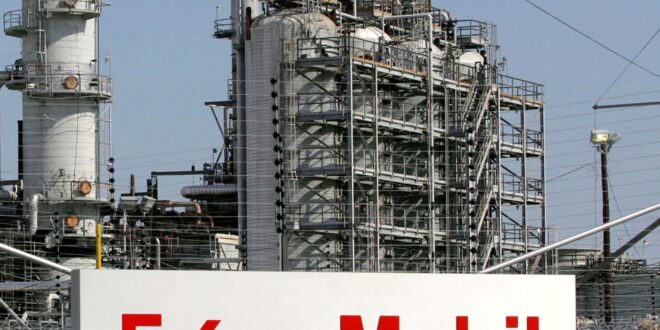Three years ago, oil prices dipped below zero and Scott Sheffield’s company — like so many other producers — was in trouble.
The long-time oil man had built Pioneer Natural Resources Co. from a family-run domestic driller into one of the largest acreage holders in the Permian Basin, a massive shale oil resource that has helped the US more than double its crude production over the past decade.
With the stock trading near a 10-year low, oil demand collapsing due to the pandemic and a financial community that viewed shale executives as spendthrift wildcatters, Sheffield made one of the biggest calls of his five decade career: He waved away a takeover approach from Exxon Mobil Corp., according to people familiar with the matter.
The decision proved prescient — Sheffield’s hold out resulted in a $60 billion purchase agreement from Exxon, four times more than the company’s value in 2020.
For Exxon, the deal represents the end of the world’s largest investor-owned oil company playing defense. Chief Executive Officer Darren Woods was forced to watch as arch rivals Chevron Corp. and ConocoPhillips made big deals during the pandemic as investors soured on his $200 billion plan to invest in fossil fuels at a time when many questioned their future.
But such is the strength of Exxon’s stock rebound in the last 18 months — in part driven by the same spending that Woods was criticized for — that the Pioneer deal became cheaper than it would have been three years ago on an all-stock basis. The acquisition makes the Texas oil giant the dominant producer in the Permian, the world’s most important basin outside of OPEC and provides the ability to flex production to meet short-term demand, which will be crucial in the energy transition.
Exxon Mobil Corp. agreed to buy Pioneer Natural Resources Co. for $59.5 billion, the supermajor’s largest takeover in more than two decades, as it seeks to become the dominant producer of shale oil.
The deal isn’t a sure thing. Winning approval from the Biden administration may prove a challenge, and analysts have questioned whether Exxon can bring down the cost of Pioneer’s drilling program as much as Woods claims. And the last time Exxon made a megadeal in shale — buying gas-focused XTO Energy for $41 billion in 2010 — it haunted the company for years as gas prices tumbled.
In an interview, Woods insisted that the newest Permian giant will enjoy costs below $35-a-barrel that will insulate it from downturns, improve recovery rates and lower emissions, resulting from the “best of both” organizations’ abilities. One of the first CEOs to see the Permian’s promise, the outspoken, cowboy-boot wearing Sheffield will sit alongside the more measured corporate executive Woods on the Exxon board, forming an unlikely pairing that will now lead America’s biggest oil basin.
The following story of how the deal came together is based on interviews with executives and people involved in transaction.
The dark
Woods inherited a company that had fallen out of favor with Wall Street. Rex Tillerson, his predecessor, had invested heavily in megaprojects that ran over budget, made a big exploration play in Russia that was later walled off by sanctions and bet on shale gas through the purchase of XTO, when the real money was to be found in shale oil.
After taking over as CEO in 2017, Woods pursued an aggressive expansion plan to rebuild Exxon, spending more than $200 billion on oil and gas projects over seven years. The centerpiece of his plan: shale oil from the Permian Basin.
But investors hated the idea. They wanted cash returns via dividends and buybacks, not investments that could take years — if not decades — to bear fruit. Unmoved, Woods held that his strategy would set Exxon up well for the eventual upturn in prices, arguing earnings could double in just seven years.
When Covid-19 struck in 2020, Exxon found itself unusually exposed. Woods’s spending spree forced him to borrow to fund Exxon’s dividend with debt, delay projects and shed staff.
In 2020, the company posted its first annual loss in 40 years, and the stock was removed from the Dow Jones Industrial Average. Meanwhile, Exxon’s arch-rivals Chevron Corp. and ConocoPhillips capitalized on the downturn with their own acquisitions.
In the second half of the year, Exxon and Pioneer discussed a possible deal, according to people familiar with the conversations. Sheffield was intrigued, but said the company was not for sale.
Sheffield had recently come out of retirement, unhappy with his successor’s performance and determined to preserve his legacy. Upon his return in 2019 he cut jobs, scrapped growth targets and was one of the first shale CEOs to win over investors by pivoting from production growth to dividends.
Behind the scenes, Sheffield sketched out strategic options, including buying up rivals to create a Permian megaproducer or selling to a supermajor — plans the pandemic threatened to scupper. He worried that majors like Exxon would scoop up independent rivals on the cheap. The industry is facing a wave of bankruptcies and the supermajors intend to “pick up the pieces,” he said in April 2020.
Sheffield had no intention of waiting around for extinction.
In 2020, around the same time as the initial Exxon approach, he convinced his board to back his play to consolidate the Midland Basin, the Permian’s eastern side, spending nearly $13 billion buying up Parsley Energy, chaired by his son Bryan, and the private equity-backed DoublePoint Energy. The deals would boost cash flow, snatch up prime drilling locations and fetch Pioneer a higher price if it were to be acquired. His third target, Endeavor Resources, was a step too far. “It’s not for sale and I don’t anticipate it coming up for sale at any time,” he said later.
Despite Sheffield waving off Woods’s interest, the pair remained friendly. But any hopes of a deal became further remote when Engine No. 1, an activist investor group with a tiny stake in Exxon, kicked off a campaign against the company for its environmental record and poor capital management in late 2020, drawing support from big shareholders including BlackRock Inc. and State Street Corp. In May 2021, the six-month campaign culminated in a shock win for Engine No. 1 that forced Exxon to replace three of its board members, a quarter of its total, with Engine’s rebel directors.
For Woods, it proved to be the dark before the dawn.
The dawn
By early 2022, the oil and gas sector had roared back to life following Russia’s invasion of Ukraine, the reopening of economies and the widespread availability of Covid vaccines. Nearly all US oil producers reaped record profits — none more than Exxon, whose earnings topped $55 billion, the most in its 140-year history. By early 2023, the stock rallied to a record high.
Woods’s countercyclical investments during the downturn began to pay off, giving him the cash and stock he needed for the big acquisition that had eluded him during the pandemic.
At the beginning of 2023, his team reconnected with Sheffield to discuss an all-stock deal. But Sheffield would only accept such a bid at a significant premium to the current share price — terms Exxon wasn’t ready to accept. In April, Pioneer had held informal talks with Exxon on a deal that could close by the end of the year, the Wall Street Journal reported.
Weeks later, Sheffield convened an employee meeting at Pioneer’s Irving, Texas, headquarters, where staffers believed he would announce plans to sell the company. Instead, he announced he would be stepping down for a second time by the end of the year; Rich Dealy, Pioneer’s longtime COO, would replace him.
But Dealy’s CEO prospects would be short-lived. By late September, Exxon, now convinced of Pioneer’s worthiness, made a formal offer, this time for a premium to its market value. On Sept. 28, the companies signed confidentiality agreements that kicked off an official negotiation process.
Unlike most big deals, negotiations in early October focused on personnel rather than price, according to people close to the conversations. Sheffield pushed hard for his own employees, including a key role for Dealy in Exxon’s new Permian division. While final positions have yet to be announced, Woods stressed in an interview that job cuts will be “minimal” and that the integration process would involve “cross fertilization” of best practices between the two groups.
Advisers and industry watchers were surprised at how quickly a deal of this magnitude came together.
Sheffield’s push for a top position for Dealy may have received a boost on Oct. 5, when David Scott, Exxon’s top Permian executive, was arrested for alleged sexual assault by police at a budget hotel in Montgomery County, just outside of Houston. Exxon said Scott “will not continue work responsibilities” as the investigation proceeds.
Just hours later, the Wall Street Journal reported that the deal was close, several other media included Bloomberg News confirmed the development. Within a week came the final announcement: Pioneer would receive Exxon stock worth $59.5 billion at an 18% premium to its market value before the media reports. On the morning of Oct. 11, Woods and Sheffield appeared alongside each other for media interviews at a studio near Pioneer’s Irving headquarters, just outside Dallas.
More money than God
To persuade US competition regulators to bless the deal, Exxon says adding Pioneer would mean its production would be less than 15% the Permian Basin’s overall output, and would boost US energy independence. It will also be a “win for the environment” because Exxon will emit fewer emissions while producing Pioneer’s barrels and accelerate its net zero target by 15 years, Woods said in an interview with Bloomberg TV.
But winning over Washington, DC could be a tall order. Last year, President Biden called out Exxon for making “more money than God” at a time when consumers were buckling under high gasoline prices. And under chair Lina Khan, the Federal Trade Commission has scrutinized several deals in oil and gas, bucking precedent.
Investors may also need convincing: Since news of the deal broke, Exxon has underperformed the S&P Energy Index. While it’s common for the buying company’s stock to drop after a deal of this size, analysts have said there’s little evidence yet that Exxon can drill better wells than Pioneer, a key reason why Woods believes he can drive $2 billion of annual cost savings over time. Investors would have preferred Exxon to make savings by cutting drilling activity instead, according to Jason Gabelman, a New York based analyst at Cowen & Co.
But Woods is confident in his plans, and more importantly, believes Exxon is now back on the leading edge of the oil industry.
“You see a natural fit and an opportunity for us to take advantage of some of the techniques we’ve been developing, some of those technologies, and applying it to what is the premier acreage in the Midland that Pioneer has,” he said.

 Iran Energy News Oil, Gas, Petrochemical and Energy Field Specialized Channel
Iran Energy News Oil, Gas, Petrochemical and Energy Field Specialized Channel



